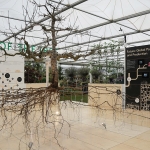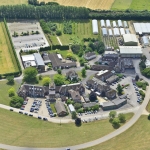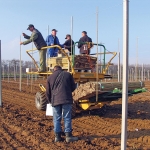East Malling’s story began March 1, 1913, when the first nine hectares of land were purchased to undertake “the study of problems met with in the actual culture of fruit trees and bushes.”
Fruit growers around the world are familiar with the name East Malling Research, a small experimental organization based in a quiet village in the southeast of England. Growers have benefited from the rootstock research conducted here from its infancy, which has made commercial production of tree fruits, particularly apples and pears, more efficient. However, East Malling’s proud heritage and legacy has encompassed more than just rootstock development and more than just apples and pears. It has extended to many perennial tree and fruit crops, to all areas of production, and from the commercial grower to the amateur gardener.
The company owes its existence to the foresight of the academics and growers who, 100 years ago, recognized the essential role that research would play in sustaining and advancing fruit growing. In fact, most national statistics show that tree fruit production has tripled or even quadrupled over the last 100 years, with even higher increases for some soft fruits.
East Malling’s story started on March 1, 1913, when the first nine hectares (22 acres) of land were purchased to undertake “the study of problems met with in the actual culture of fruit trees and bushes.” It had one laboratory, one office, and two permanent members of staff. Today, East Malling Research sits on 200 hectares (500 acres) of land and has about 80 staff members, of whom about half are scientists.
Early results were extremely promising, and despite the modesty of the enterprise, industry was getting the information it needed, and it wanted more. Dissemination of results was driven by the second director, Ronald Hatton, who travelled the world spreading the news of East Malling’s work and who encouraged his scientists to reach out and to collaborate as much as possible.
The site steadily expanded over the next 30 years; new laboratory buildings were built on the growing land holdings, and many more scientists joined the expanding organization.
Rootstocks
One of East Malling’s first and most important successes was the collection and typing of apple rootstocks and the propagation and release of selections with defined effects on precocity and vigor. The Malling (M) series was followed by the Malling Merton (MM) series, bred jointly with the John Innes Institute for resistance to woolly apple aphid. These rootstocks are used in virtually every part of the world where apples are grown commercially. Further rootstocks were selected for pear (Quince A, Quince C), plum (Myrobalan B, Brompton, St Julian A, Pixy), and cherry (Colt, Cob, Charger).
Growth and physiology of roots was studied extensively to determine the role of roots in water absorption, association with mycorrhizae, impact of soil management, planting density, irrigation, cropping levels, and below-ground production, now of value in assessing effects of climate change.
Practical plant husbandry studies laid the foundation for modern orchard systems. Important advances were made in understanding and manipulating plant hormones that have a crucial influence on responses to stress conditions, root growth, flowering, and fruit formation and ripening. This facilitated the development of auxin sprays to delay preharvest drop of fruit and chemical control of tree growth to optimize cropping potential.
CA storage
East Malling collaborated with, then continued the work started at the Ditton Laboratory, leading to the development of controlled atmosphere storage of fruit. Along with extensive research on the preharvest factors that affect storage potential (nutrition, harvest time, storage diseases and disorders), this enabled consumers to enjoy affordable fruit year round.
More than 120 new varieties of apple, pear, cherry and plum, strawberry, raspberry, ornamental plants, and hops have been bred at East Malling, many of which set new standards for flavor or extended the season. East Malling led the world in developing techniques to characterize the incompatibility groups of cherry.
Basic and practical research was conducted to optimize rooting of hardwood and softwood cuttings. Robert Garner’s The Grafter’s Handbook became an essential text for propagators.
Throughout its existence, East Malling has focused on control of the many pests and diseases that attack horticultural plants. Through understanding their biology, ecology, and epidemiology, East Malling has produced integrated control systems that minimize pesticide residues in fruit.
Today, East Malling Research has the United Kingdom’s largest team of scientists conducting research for application in commercial horticulture, focused primarily on perennial and clonally propagated crops and their interactions with the environment, for both public and private customers.
There are three strands to the current research program. “Genetics and Crop Improvement” focuses on the genetic improvement of rosaceous crops with emphasis on strawberry improvement, molecular genetics, rootstock genetics, and commercial breeding. A fundamental advance has been enabled by the availability of molecular analysis. The molecular genetics of plants and individual traits are explored to facilitate marker-assisted breeding of strawberry, cherry, apple, and pear rootstocks.
The second program, “Pest and Pathogen Ecology for Sustainable Crop Management,” aims to understand the ecology of pests, pathogens, host plants, and natural enemies at the community, whole organism, and molecular levels in order to develop more effective and sustainable management methods for horticultural crops.
The final program, “Resource Efficiency for Crop Production,” aims to utilize and develop the perennial crop habit to provide a sustainable and economic means of securing food supplies with a growing population and in a changing climate. The main areas of research are in delivering resource-use efficiency, understanding crop and environmental interactions, and manipulating below-ground biotic interactions.
East Malling has a key role in assisting the delivery of many government policies, especially in relation to food security and healthy diets. Over time, East Malling has had to adapt to the changing landscape of research need and opportunity. For the foreseeable future, East Malling must deliver innovations to increase production and cope with a more variable and changing climate, in ways that are profitable for producers. However, these innovations must also enhance the provision of other ecosystem services, increase the efficiency of resource use, result in less waste across the food chain, and minimize greenhouse gas emissions.
East Malling Research is rapidly emerging as the United Kingdom’s preeminent center for horticultural research, still engaged in the issues that challenge growers. The future looks productive and assured, and international collaborations are increasing. •











Leave A Comment